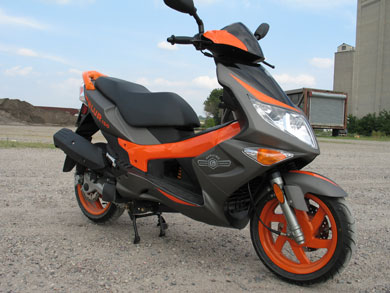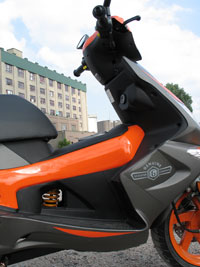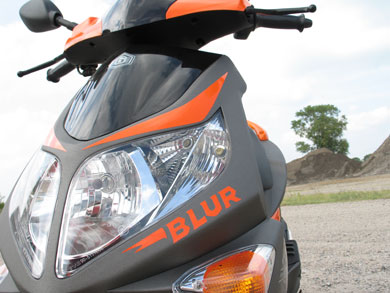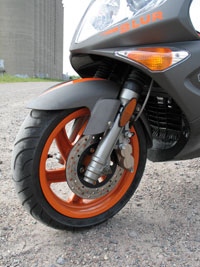
This my first review of a scooter in more than ten years of writing 2strokebuzz. My first scooter was a vintage Vespa and have pretty much stuck to what I know. I’ve taken a few spins on various modern scooters, and have been impressed by some, and not by others. The Blur impressed me.
Just by way of disclaimer, before we get started, I just want to point out that even though I’ve been writing about scooters for ten years, I’m probably not the world’s top expert, especially when it comes to modern bikes, and I had a limited amount of time to try this bike out. What I do have to offer is an unbiased consumer impression, from the perspective of a longtime vintage scooterist, combined with a certain amount of research and knowledge, that I hope will be helpful to anyone reading this. Product reviews on the internet range from the amazingly technical and informed to the insipid, hopefully if you’re using this review to make a purchase decision, it will be clear where in that range this review fits and you will seek advice from other sources as well.
New scooters appear on the international market often, and usually by the time they arrive in the United States (if they ever do arrive here), they’ve been analyzed to death by the European press and we know all about them. 2strokebuzz has reported on several new bikes recently, in some cases before the manufacturers even announced them, but it will be months before we see a Piaggio MP3, for instance, in person. Kymco flying 2strokebuzz to a press junket in Taiwan for a long weekend seems realistic only when you compare it to the even-smaller odds of Piaggio flying me to Pisa.
So when the chance to be the very first American “journalist” (sorry) to see and ride Genuine’s new Blur 150 fell in my lap a couple weeks ago, I did what anyone would do. I jumped at it. Then I procrastinated and sat on the story for one two three weeks, until the scooter was in shops and was old news, to finish the review.
 Ever since Genuine announced this spring they’d be importing the PGO Bubu (as the Buddy) and PMX (as the Black Cat), we heard that more PGO models would follow. The Buddy arrived in early June to almost universally positive word-of-mouth. Genuine’s P.J. Chmiel had extensively test-ridden the PGO G-Max, and I hoped it would be the next Genuine model (though some held out hope for the three-wheeler). When the Blur was announced early this month, I correctly guessed its identity as the G-Max. (The Rattler, Genuine’s version of the PGO PMS, was apparently announced simultaneously, though we were a couple days late on that one). We talked to Roy Park at Genuine Scooters and he offered us a close look and a short ride at the No Direction Home rally in Minneapolis, a few days later.
Ever since Genuine announced this spring they’d be importing the PGO Bubu (as the Buddy) and PMX (as the Black Cat), we heard that more PGO models would follow. The Buddy arrived in early June to almost universally positive word-of-mouth. Genuine’s P.J. Chmiel had extensively test-ridden the PGO G-Max, and I hoped it would be the next Genuine model (though some held out hope for the three-wheeler). When the Blur was announced early this month, I correctly guessed its identity as the G-Max. (The Rattler, Genuine’s version of the PGO PMS, was apparently announced simultaneously, though we were a couple days late on that one). We talked to Roy Park at Genuine Scooters and he offered us a close look and a short ride at the No Direction Home rally in Minneapolis, a few days later.
Background
Genuine Scooter Company, of Chicago Illinois, is a newer sister company of Scooterworks USA, who has been selling vintage scooter parts for almost 20 years. Genuine started up their company around the Stella, a rebadged LML Star, which is an Indian copy of the Vespa PX150. The Stella proved to be immensely popular, outselling similar scooters from Bajaj and even Vespa themselves. Unfortunately, LML was a bit unpredictable and occasional quality issues were followed by a labor lockout at the factory that have, barring a miracle at this point, brought an end to the model.
Genuine was clearly thinking ahead, just as news of the LML labor strife appeared, they announced a similar deal with Motive Power Industry Co, Ltd., of Taiwan, maker of PGO scooters. Even though Asian scooters (aside from Japanese and Indian) have (mostly justifiably) developed a bad reputation in the United States, and several American importers, notably T’NG, have been burned by bad deals with Chinese suppliers, Kymco of Taiwan has built a solid and reputable operation here and worldwide, and PGO appears to parallel Kymco in many ways. Both engineer, design, and manufacture their own scooters, and both have a good worldwide reputation for quality and parts supply. Additionally, both brands feature model names that, in English, range from comical to downright embarrassing: Grand Dink, PMS, BuBu, Bet&Win… you get the idea. Though Kymco’s U.S. importer wisely changed some product names, Genuine took that idea a step farther and developed whole new identities for their scooters, better targeted to the U.S. market.
The Blur is a perfect example of this. While “G-Max” isn’t as cringe-inducing as “PMS,” Genuine was wise to re-name it. Some fairly-boring color combinations for the worldwide market were ditched for a striking glossy-orange and matte-charcoal paint scheme that will hopefully attract more buyers than it repels (even Genuine’s site admits that the colors are not for everyone’s taste). In my opinion, while I think the colors and the name are fantastic, the bike is a bit overbranded, and I’d probably scrape off a few of the extraneous orange vinyl accent decals and maybe a “Blur” logo or two.

Design
Design-wise, the bike is quite modern-looking, which I prefer to the many “retro” scooters out there. “Vintage” is great, “modern” is great, but I can’t get into “retro.” While not as “out-there” as the Italjet Dragster, which still looks futuristic ten years after its introduction, the style of the Blur mimics that of the popular Gilera Runner or the Peugeot Jet Force (both highly-regarded, but unavailable in the U.S.). While certain cues were clearly borrowed from each of those scooters, it’s unfair to call the Blur a “knock off” or “copy,” it is an entirely original, if a bit derivative, design, unlike the hundreds of “fake Vinos” out there.
The Blur also avoids the “plastic bodywork stuck to a black metal tube frame”-look of many modern scooters. It is plastic bodywork stuck to a black metal tube frame of course, the wide orange center channel bar which appears to be a bit of exposed frame is more or less decorative plastic. Nevertheless, the Blur has a very solid feel, good paint, and the build quality appears high, there are no sloppy punch-outs or wobbly plastic. The decals don’t match the paint exactly, and seem a bit flimsy, but as I said earlier, all the easier to peel them off.

Electrical/Controls
Though I didn’t ride at night, the lights seemed adequate, though what appears to be a dual headlight is actually one large divided headlight with two smaller (parking?) lamps to the sides. The Asian-market turn signals are luckily retained, unlike many modern scooters, nothing looks tacked-on to meet DOT requirementss. The controls and speedometer are well-designed and easy to read, the speedometer also features a tachometer (it’s an automatic! what a country!), odometer, a kill-switch dummy light, a gas gauge, turn signal indicators, and the ubiquitous LCD digital clock. The column lock/ignition switch also unlocks the seat and pops open the gas cap, without having to remove the key from the column, a great feature that should prevent scratches, lost keys, and siphoned gas.
Ergonomics
I’m 5’10” and have a giant ass, and I found the bike to be comfortable and well-proportioned during a brief ride on bumpy terrain. Being used to the floor space of a vintage scooter, the footroom is a bit tight, but well-located, and there’s a bit of wiggle room. Stepping onto the scooter was not as easy as most step-through scooters, I managed to put a big dusty footprint across the Runner-like high center channel. The seat was very comfortable, though the passenger area is small and raised, reducing the amount of space to slide around but creating a bit of a backrest. I would suspect a passenger would be a bit cramped on a longer trip, but comfortable enough for quick trips around town (unobtrusive footpegs flip down when needed). Under the seat was space for a helmet and access to the battery. There is no other storage space, aside from a small-but-attractive rack mounted on the tail. It features electric or kick start, and has a sidestand and a centerstand.
Power
 I didn’t come close to pushing the bike to its limits, and I admit that I missed shifting, but the Blur accelerated quickly, went fast, and stopped even faster. When you’re used to 10″ wheels and 30-year-old drum brakes, 13″ wheels with front-and-rear discs are bound to feel amazing, and they did, even on a dusty gravel road. The suspension was equally great compared to a vintage scooter. The Blur has 6-point linkage rear suspension with a center-mounted shock which is visible (like the Peugeot Jet Force) through a cutaway in the center channel. Gimmicky, but it looks trick and feels good. The front end features teloscopic forks. Other, more experienced and better-insured test riders have assured me it hugs turns knee-down with the best of them (It’s already been doing well in races in Asia). Genuine Roy had already scuffed the the sidestand on the model I rode. The two-valve (not four-valve as I originally posted) single-cylinder 150cc four-stroke accelerates quickly and is plenty fast for city riding. With a GPS-tested top speed just over 70mph, it should be stable on the highway, though it’s definitely not designed as a highway cruiser. Its sweet spot, speedwise, is between 50-60 mph. PGO recommends premium gas, which might put a small dent in your ‘save gas money’ argument, though at a quoted 90mpg and a 2-gallon tank, you’re still way ahead of a car, mileage-wise.
I didn’t come close to pushing the bike to its limits, and I admit that I missed shifting, but the Blur accelerated quickly, went fast, and stopped even faster. When you’re used to 10″ wheels and 30-year-old drum brakes, 13″ wheels with front-and-rear discs are bound to feel amazing, and they did, even on a dusty gravel road. The suspension was equally great compared to a vintage scooter. The Blur has 6-point linkage rear suspension with a center-mounted shock which is visible (like the Peugeot Jet Force) through a cutaway in the center channel. Gimmicky, but it looks trick and feels good. The front end features teloscopic forks. Other, more experienced and better-insured test riders have assured me it hugs turns knee-down with the best of them (It’s already been doing well in races in Asia). Genuine Roy had already scuffed the the sidestand on the model I rode. The two-valve (not four-valve as I originally posted) single-cylinder 150cc four-stroke accelerates quickly and is plenty fast for city riding. With a GPS-tested top speed just over 70mph, it should be stable on the highway, though it’s definitely not designed as a highway cruiser. Its sweet spot, speedwise, is between 50-60 mph. PGO recommends premium gas, which might put a small dent in your ‘save gas money’ argument, though at a quoted 90mpg and a 2-gallon tank, you’re still way ahead of a car, mileage-wise.
Summary
As I said in the introduction, while I’m clearly a scooter-culture-and-news nerd, I’m not the most technically savvy guy, I don’t ride as much as most scooterists these days, and my experience with modern scooters is fairly minimal. That said, this bike impressed me quite a deal. It is comparable in many ways to the Kymco Bet&Win 150, which along with the Vespa LX150, I’d consider to be the Blur’s competition in the American market. As a vintage scooter fan, I find most modern 50cc-125cc scooters too slow and flimsy, and most 250cc and larger scooters too big and heavy. The 150cc market is a little underserved, I’d argue it’s the ultimate combination of displacement vs. physical size for a scooter.
If I could afford and obtain any modern scooter, it would be the 2-stroke Gilera Runner 180. Since Piaggio is almost certain to never bring the Runner to the U.S., and who-knows-what’s going on with Kinetic’s Indian-made “Dragster,” the Blur is tempting. Sure, the Blur is no Runner, but it looks the part, seems well-built, is being sold by a trustworthy company (stop laughing, Scooterworks had been around for years before Piaggio came back, and I’d put money on them outlasting Piaggio’s current US operation), with a 2-year warranty and 1-year roadside assistance. Best of all, it’s cheaper than some used grey-market Runners I’ve seen. I’m seriously considering trading in one of the rusty, cable-eating, oil-leaking vintage bikes in my garage and selling out to the four-stroke automatic world.
Genuine Scooter Co: Blur.
PGO Taiwan: G-Max Evo 150.
More photos from 2strokebuzz.
Thanks to Genuine Scooter Company, specifically Roy Park, for letting us try out the bike, and to Scooterville of Minneapolis and Pride of Cleveland Scooters for additional information.
The Piaggio Fly has the same established Leader engine as the LX150 and is 100 dollars less than the MSRP of the Blur. Just saying is all.
Piaggio’s scooters are often the yardstick by which other scooters are judged (and priced), and you’re right, the 150cc Leader is a proven engine. but the design of the Fly just doesn’t do it for me, it’s so generic looking. It has some merits, to be sure, though. Both are definitely worth looking at. Looking around, there are more 150s out there than I’d thought, I guess there are plenty on the market, you just don’t see many on the street. Maybe once people are spending that much money, they feel it’s worth stepping up to a 250cc. But as I said, i think most 150cc scooters fall in that sweet spot of scootering: small enough to throw around, but powerful enough to keep up. I love squeezing those last few MPH out, if I had a scooter that did 80, I’d never get to do that.
Funny that the Fly’s 12-inch wheels look so much bigger in photos than the Blur’s 13-inchers.
This is a model I’ve been looking forward to trying out soon.
By the way, have you ridden a Runner 180? They are amazing machines, but as I understand it Piaggio phased out the 180cc 2 stroke in favor of the 200cc and 250cc 4 strokes they now have. More power, more torque, lower emissions. Less tune up potential, but it makes sense for them, I guess.
As far as the Fly vs. the Blur, they are two completely different machines. The Fly is going to be slower than the Blur and as tried and true as the LEADER engine may be it’s a fair bit thirstier than many other engines of the same size. I’m lucky to ever break 60mpg on mine.
Then again, I find myself always a bit partial to scooters that come in orange.
I’ve never ridden any Runner, I’ve never even seen one in the USA, but they were all over Dublin, London, and Paris and I stained many a flat-black paintjob with my drool. You’re correct, they stopped making 2-strokes (and the 180) a while ago, but I’d happily settle for a 200 or 250 4-stroke (though that’s an entirely different budget range). They were also redesigned recently, It’s a toss up which Runner design I like better.
I’ve never ridden a Fly. i’ve heard they’re slowish, but the Blur isn’t ridiculously fast, either. I’d imagine there are plenty of LEADER hop-up kits out there, and probably none (for the time being) for PGO’s proprietary engines, so that’s a good point. Also, you’re right, LEADERs aren’t the most fuel-efficient things out there.
You’re right. The Swingline cordless stapler does kind of remind me of the Blur.
Bryce hepped us to a review of the UK versions of the PGO GMax, good reading.
In other news,Genuine is sponsoring Cannonball rider John Smith of Richmond (aka jrsjr on 2sb), he will be riding the Blur. If there was ever a good test for a scooter, that’d be it!
Definately a good read. It would be cool to see the 250 in the U.S.
Note that while the UK-version 250 uses the same frame, the suspension is different. Not a dealbreaker, though.
The 250cc engine in this same frame would be a screamer, compared to the Kymco People and Bet&Win, which have entirely different (larger, heavier) frames and bodywork for their 250cc versions. It would also raise the price quite a bit. The UK 250 version costs a whopping US$5500 compared to US$3500 for the US 150 version. Also note that the UK 125cc version costs US$100 less than the US-market 150cc, interesting!
The LEADER engine has been out for the better part of a decade, and has been sold in a large number of scooter brands and models. At my last count, 7 brands had used it in one model or another, including Piaggio and Vespa. And while the Fly has a slightly sporty look and 12″ wheels, Derbi’s GP1 and the Gilera Runner are the sport scoots in Piaggio’s stable.
While the rear suspension is different, I got a good look at the PGO version of the G-max at Indy. The engine and CVT are still unsprung weight, but the geometry is very different from that of a conventional scooter mounting. Additionally, in the UK a 17.5% Value Added Tax is part of everything you buy there. If that is subtracted, it works out to $4700. Which is fairly close to Piaggio BV250 pricing, though a few hundred above some of the Kymco 250s. By comparison, it will be a rocket ship, as was already mentioned.
I don’t know. I just cant get behind this…
Chad, just picture it in matte black with the robocop logo on the side of it and a few body panels missing, with a chubby goth chick with emotional problems and a light meth habit standing next to it, and I think you’ll see the light.
that definitely makes it more appealing… but you can do THAT with any scooter.
I got a call from Randolf Garner, he was complaining that we got the “least powerful” of the Blurs (G-Max 150’s). No Turbo Exhaust, No 4 Valve Head.
My Response;
Everyone who’s tested it agrees that it is the fastest, quickest, and best supported/warranty 150cc scooter you can buy in the US. That being said, your only complaint is that it could be better, and it doesn’t kick your Runner 180 2 Stroke’s ass. Well, you can’t go down to your local Gilera dealer and buy a new or used Runner 180 (or bigger).
Nope, it’s not a Piaggio, and nothing I’ve learned in the past 15 years suggests a scooter has to be Piaggio to be good.
I’m running mine on 87 Octane as I see no reason to use anything else. 90 mpg at damn near WFO all the time.
I rode this Blur before anyone else. I liked it alot. As a owner of 3 Piaggio 180 2T I can say that the Blur is a smoothe, sprite and very drivable scooter. Too bad the foot area is not larger otherwise I would add one to my stable
In response to Randolph, I refer back to the price comparison. Sure, there’s a better model, but it costs more. There’s always a ‘better’ bike out there, but is it in your price range? I think $2500 to $3500 is a good price point for a scooter. If I’m paying $5000 for a scooter, or want to go 120mph, i’m going to start looking at motorcycles.
Okay, I’ll make a confessoin, part of the reason I mentioned the Fly 150 at all is that I just bought one. And I just wrapped up a summer job working at the Chicago Piaggio/Vespa dealership, Olde Town Motorcycle.
Got to show my bike and my people love.
Ha, I have a confession to make, too, but I’ll confess it tomorrow. And then we can race.
I saw it at the Cobra but I never saw you on it.
We’lll have to race later.
Two things I just realized (years later) are wrong:
1) It appears a few early sample bikes had sidestands, but I haven’t seen a sidestand on a blur since this demo model.
2) There’s a lot of debate over premium gas in Genuine scooters. Most experts say regular gas is fine, premium is specified because gas is rated using a different method in asia. I’ve been using regular gas for two years with no problems..
i am wanting to buy this scooter but wot cc is the engine ??
thanks